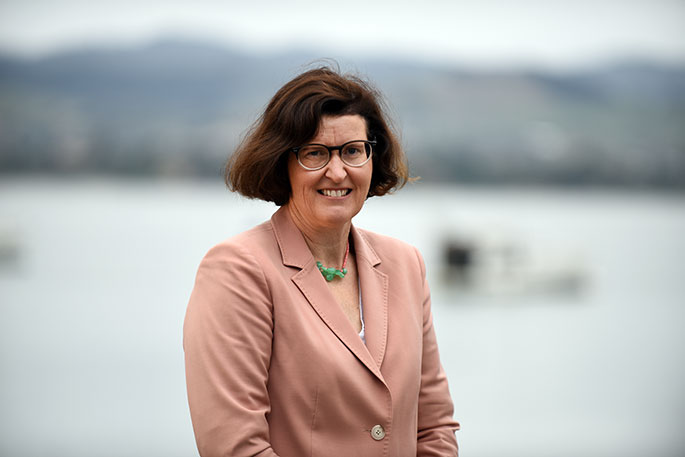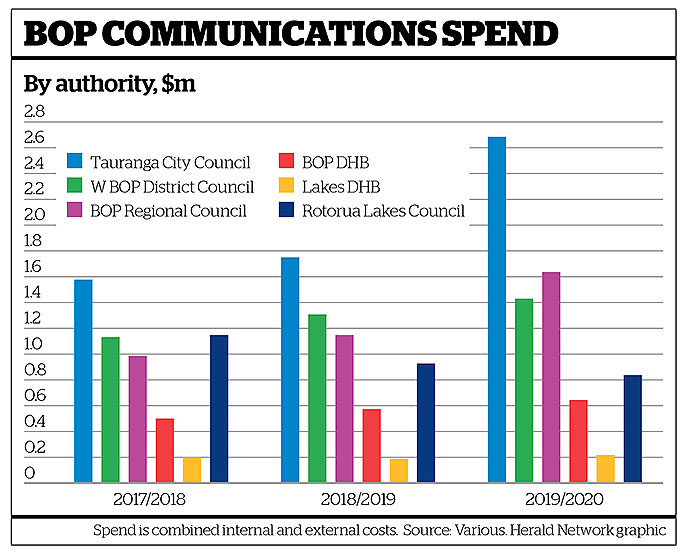Bay of Plenty local government organisations shelled out more than $7.4 million on communications and public relations last year - with the Tauranga City Council spending just over $2.6m in its efforts.
The next highest spender, Bay of Plenty Regional Council, spent just over $1.6m.
The region's other councils, Western Bay of Plenty District Council and Rotorua Lakes Council spent $1,429,700 and $837,000 respectively.
The Bay of Plenty Regional Council has the largest population of the councils with a population of around 307,000 followed by Tauranga with 144,700, Rotorua with 72,500 and Western Bay with 51,231.
The data was obtained by NZME from Tauranga City Council, Rotorua Lakes Council, Western Bay of Plenty District Council, the Bay of Plenty Regional Council and the Lakes and Bay of Plenty District Health Boards under the Official Information Act and the Local Government Official Information and Meetings Act.
The request found Tauranga City Council spent the most on communications out of the six, spending $2,680,754.00 in the 2019/2020 financial year.
That figure was a combination of the in-house spend on staff - just over $2m - and its spend on external contractors - nearly $629,000.
In 2019/20, there were 15 staff members employed in communications and engagement at Tauranga City Council, made up of 13.55 equivalent full-time equivalent roles.
The council did not divulge the salary of the highest paid staff member, citing privacy.
Tauranga's biggest spend on a single project was $209,426 for contracted communications work regarding the Waiari Water Treatment project between 2017 and 2020.
It also spent $161,272 on contracted communications work on the southern pipeline between 2017 and 2019, and $122,665 on the same for the failed Harington St transport hub from 2017 to 2020.
 Tauranga City Council people and engagement general manager Susan Jamieson. Photo / File / George Novak / Bay of Plenty Times.
Tauranga City Council people and engagement general manager Susan Jamieson. Photo / File / George Novak / Bay of Plenty Times.
Tauranga City Council people and engagement general manager Susan Jamieson says communication and engagement is an 'extremely important part of [the] council's business”.
She sas the organisation needs to refine efficiency and effectiveness and in recent years has relied more on 'external resources” as it provided flexibility with specific projects, although this is under review.
'People rely on a range of essential services the council provides ... they therefore need to know if there will be any change to the way those services are delivered – water shutdowns, or road closures, for example.”
She says communication is two-way and part of the job is to provide the opportunity for public feedback.
'Being constantly available and responsive comes at a cost and while we are keen to find better and more economical ways of communicating and engaging with our community, there is a service expectation that we are obliged to meet.”
Former Tauranga mayor, current Bay of Plenty regional councillor and president of Local Government NZ Stuart Crosby says communicating with the public is 'one of the fundamentals of the democratic process” and often a legal requirement.
 Local Government NZ president Stuart Crosby. Photo / File / George Novak / Bay of Plenty Times.
Local Government NZ president Stuart Crosby. Photo / File / George Novak / Bay of Plenty Times.
'It's people's right to know what's going on and it's their right to participate in that process.
'You can't ... engage properly unless you have the right amount and accurate information - that's what councils should provide.”
He says the $7.4m spend is 'modest” when considered in context of the relative organisations' operating budgets but councils needed to make sure communication was useful and effectively reached the public.
Bay of Plenty Regional Council's overall figure was made up of almost $1.03m on its 17 staff, which was made up of 15.5 FTEs.
 Bay of Plenty Regional Council chief executive Fiona McTavish. Photo / File / George Novak / Bay of Plenty Times.
Bay of Plenty Regional Council chief executive Fiona McTavish. Photo / File / George Novak / Bay of Plenty Times.
The regional council's spend on contractors has more than tripled since the 2017/18 financial year, when it spent just over $166,000. It spent more than $601,000 on communications contractors in 2019/20.
In its response, the regional council states this is due to a communications manager vacancy.
Bay of Plenty Regional Council chief executive Fiona McTavish says communication and engagement with communities and stakeholders is 'critical”.
She says the regional council is different to city or district councils as it had to communicate with a larger population across a larger geographic area.
The regional council's 2020 residents survey results showed the awareness level of the difference between regional council and other councils was low, she says.
'We are working hard to make sure we are communicating with all residents in the region and that there is community awareness about the important work we do.”
Asked if she believed the money was well-spent, McTavish says the organisation is 'focused on continuous improvement” and has restructured its communications team at the beginning of the year to ensure efficiency.
She says it is the regional council's duty to provide full transparency to the communities it served.
 What the Bay of Plenty's local authorities spent on communications since 2017. Graphic / NZME.
What the Bay of Plenty's local authorities spent on communications since 2017. Graphic / NZME.
"NZME also requested what the highest paid regional council communications staff member received, and while the specific figure was withheld due to privacy, the regional council confirmed the mid-point of the salary band was $148,283 as at July 1 2019."
Other organisations, such as the Western Bay of Plenty District Council, which had a significantly smaller team - five people to Tauranga City Council's 15 - did report the salary.
The highest paid communications and public relations staff member at the Western Bay of Plenty District Council received a salary of $155,925 in 2019/2020. That figure has risen by more than $30,000 in three years.
The Western Bay of Plenty District Council spent $1,429,700 on communications and public relations in 2019/20.
That included $1,211,816 for five internal staff and $217,884 for external contractors.
The other organisation to reveal the salary of its highest paid communications staff member was the Bay of Plenty District Health Board, which had seven staff members - 6.5 FTEs - in 2019/20.
The figure was $133,061.00, up from $121,854 in 2017/2018.
Rotorua Lakes Council, spent just over $837,000 overall, including $791,439.68 on internal staff and nearly $46,000 on external contractors.
Its spend on internal staff had dropped from about $832,000 in 2017/2018, and its spend on external contractors had dropped significantly, from more than $315,000 in 2017/18 to $45,669 in 2019/20.
Rotorua Lakes Council also refused to reveal the salary of its highest paid staff member, citing privacy. Its team has 11 staff members working an equivalent of 8.9 full-time equivalent roles.
The two district health boards came in last, with the Bay of Plenty District Health Board spending more than $669,000 last year, and Lakes District Health Board spending just over $218,000.
Bay of Plenty District Health Board spent almost $560,000 on internal staff and just over $109,000 on external contractors.
The Lakes District Health Board spent more than $200,000 on staff and advertising and $17,430.00 on external contractors. It had not spent anything on contractors the two previous years.




0 comments
Leave a Comment
You must be logged in to make a comment.